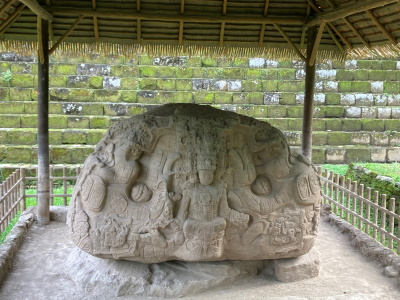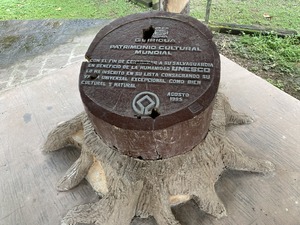Quirigua

The Archaeological Park and Ruins of Quirigua comprise an ancient Maya site renowned for its outstanding carved stone stelae.
The monuments centered around the Great Plaza are remarkable for their complexity and the artistic skill shown in the sculptures. Their hieroglyphic texts and sculpted calendars are an essential source for the study of Mayan history and culture. Quirigua in the 8th century was an administrative center and monuments were erected marking the end of five-year periods.
Community Perspective: a small site, but the stelae and sculptures are in exquisite condition. The surroundings with numerous birds and working banana plantations are pleasant as well.
Map of Quirigua
Community Reviews
Frédéric M

I visited Quirigua during my trip to Guatemala in November and December 2021. I visited the site on my way from the town of Chiquimula (base for visiting Copán) to my waterfront hostel in Rio Dulce (Castillo de San Felipe de Lara is nearby). The bus from Chiquimula left me directly at the intersection of the main road and the path to the ruins, where I was able to catch a tuk-tuk to the site. I left my luggage at the reception and set off to explore the ruins.
Quirigua is rather small and can be visited quickly (I spent just over an hour there, taking my time and stopping frequently to try to identify the birds singing in the forest). Nevertheless, it contains treasures of Mayan art and culture. If their architecture and grandiose urbanism can be admired elsewhere, there is no better place than Quirigua and Copán to appreciate their stelae, sculptures and statues. The works in Quirigua are all protected by thatched roofs. This is wonderful for their preservation, but it creates shadows and backlighting that are difficult to manage for photos when the sun is shining.
Stela E (photo) rises 8 meters above the ground, weighs 60 tons and is the largest stela in the Maya world. The dozen other stelae are not to be missed, however, as are the gigantic zoomorphic sculptures. A monumental ceiba, the sacred tree of the Maya, stands in the middle of the Gran Plaza. At the far end, there is a rather unremarkable acropolis, neither really impressive nor interesting. It is however guarded by the most striking zoomorphic sculptures. Frogs, turtles, snakes, jaguars and human figures can be seen here.
I thought I would enjoy my visit to Quirigua, but I was expecting to visit a relatively minor site. However, I enjoyed my visit much more than I expected. The weather was perfect, the site almost deserted, the birds numerous, the ruins well presented, and the staff charming. What was supposed to be an anecdotal detour in my itinerary turned out to be a favorite. Since no tuk-tuk was in sight for the return trip, the visit ended with a walk of just over 3 kilometres through the banana plantations to get back to the road. This definitely added to the charm of the experience.
Els Slots

This site hasn’t been reviewed for 13 years, so I think Quiriguá deserves to be put into the spotlights. With this visit, I also completed the list of 9 WHS connected to Mayan culture. And every time you think: “I’ve seen so many Maya sites already, what can this one possibly add?” But they all have different qualities. Quiriguá has the best-preserved sculptures.
The Quiriguá archaeological park has suffered severe hurricane damage from Eta and Iota in 2020 and has only reopened in June 2021. They had to remove 12 swimming pools full of mud and water, which left certain areas flooded up to 1.8m.
During my visit in February 2022, nothing of that damage was visible anymore and the site looked very well cared for. At the entrance, you get a site-specific ticket and a booklet in English (both rare in Mexico or Central America). Signage is in both Spanish and English. There is a (new?) boardwalk that takes you along the monuments, so you don’t have to walk on the grass. It had been raining for 2 hours before my visit, and the ground had turned soggy again.
The site comprises a plaza where the sculptures have been resurrected and an acropolis with a few ruined buildings and a ball court. Parts of the site are also unexcavated, you can see unnatural hills where something must be hidden underneath. The sculptures often had fallen down or were broken when they were rediscovered in the late 19th century, they have all since been restored and each one has a thatched cover against the elements.
Directly on the first stele, I discovered something peculiar: historical graffiti from 1881. 1881 was an ominous year in the history of Quirigua, as that was when the British explorer and archaeologist Alfred Maudslay first visited. He later recorded all the monuments in detail and made paper and plaster molds of the hieroglyphic inscriptions, which were shipped to the Victoria and Albert Museum and the casts to the British Museum. It wasn’t Maudslay who made the graffiti, but in his recordings, he also referred to them.
All stelae are in exquisite condition and by far the best ones I have seen at any Maya site, even better than Copán. The site also specializes in zoomorphic and anthropomorphic sculptures, which are very good as well. The Acropolis isn’t a match for any of the other Maya sites – you really have to come to Quirigua for the stone carvings. The complex isn’t large, it takes about an hour to see it all. The site is open daily between 8 and 16.30. The area is also good for birds and I saw an agouti as well.
Quirigua lies in the south of Guatemala, only 4km from the main road that crosses the south; so with a rental car, it’s an easy visit. By public transport it also isn’t that hard: I went by bus from Guatemala City to Los Amates (4.5h with a fairly luxury coach by Litegua). From Los Amates you can take a tuk-tuk to the site, a few kilometers further along the road. To continue your journey after the visit, go to the next town Morales and catch a bus north from there for example to Flores (5.5h with Fuente del Norte, for me it included free training in staying zen because of 8(!) police checks and 2 preachers on the bus).
Before moving on, I stayed overnight at the Posada de Quirigua. This small lodge in Quirigua village is owned by a Japanese woman and has been running for 17 years. It is basic but clean and has useful amenities like hot water, wifi, and hammocks. She cooked me a wonderful Japanese dinner as well (it’s not easy to get soy sauce, nori, or even rice in rural Guatemala!). The posada cannot be found via the generic booking sites, do contact her via her own website if you want to stay there.
Read more from Els Slots here.
Roy C. Frink
I appreciate the way the various organizations that could have ruined Quirigua have preserved and beautified the site. It was a thrill for me to climb the large stone temple building and look back at those magnificent, tall, twisted trees surrounding the large carvings. I have been interested in the Mayan mystery ever since teaching 7th and 8th grade history in the 1980's. I am increasingly convinced that the people who built these incredible stone cities came from Egypt, probably on the reed boats. The building technique is so similar to the early Egyptian "step" pyramids.
W. Robin Upton
I was in Bananera in, I think 1970, looking into the construction of worker housing. We were taken on hand-driven rail cars to the Quirigua site. One entered via a long tunnel through the jungle and suddenly exited onto the site. A breathless experience going from the dense jungle canopy unto this field of giant stelae. The field was quite well maintained. Some other excavations seemed to be in progress, but by whom? The United Fruit Company maintained the entrance and the grassy area where the stelae were, but were not involved with the excavations. The descriptions elsewhere on this site conform to mine. We went two or three times, but we met but one American backpacker. It is not Tikal, but the stelae are wonderful, indeed.
J.
As an archaeologist, I found Quirigua interesting, but I do not recommend it to tourists. Stop if you happen to be passing by, and check out the tallest of all the Maya stelae and some cool zoomorphic sculptures. However, don't expect much else - the site is tiny, the environment is extremely muggy, and the artwork is a lower-quality knock-off of that at nearby Copan, Honduras. Definitely, definitely, definitely visit Copan! Copan and Tikal are the two Maya sites everyone should visit, in my opinion.
Solivagant

The ruins of Quirigua in Guatemala do not in any way compare with those of the “nearby” Mayan cities of Tikal and Copan or of those in Yucatan such as Palenque, Chichen Itza and Uxmal. Its main advantage is its relatively easy access from Guatemala City 220 kms away on the main highway to Puerto Barrios. If you have the time or are passing relatively near by on your way to Copan (with which Quirugia was closely associated culturally) or the coast then it is certainly worth the slight detour to take in this WHS.
Its main “glory” lies in the collection of “stelae”, 9 of which are laid out around a “football field sized” central grass plaza. The remainder of the city, which dates from 8th century is largely un-restored, so you will not see the profusion of ball courts and pyramids of other Mayan cities. The stelae are however considered the finest examples of Mayan carving anywhere and, because of the hardness of the local sandstone (elsewhere the Mayans tended to use limestone), have been preserved in amazing detail
Community Rating
- : Michal Marciniak Tamara Ratz João Aender
- : John Smaranda PabloNorte
- : George Evangelou Eric Lurio Pincze Christoph Alejandro Lau
- : Els Slots Hanming MichaelH Little Lauren Travels Lucio Gorla Mahuhe RobRos Carlos Sotelo Kasper
- : Clyde Philipp Leu Gary Arndt Javier Clem C Don Irwin Miguel Marquez Frédéric M
- : Solivagant
- : Richardleesa Zoë Sheng
Site Info
- Full Name
- Archaeological Park and Ruins of Quirigua
- Unesco ID
- 149
- Country
- Guatemala
- Inscribed
- 1981
- Type
- Cultural
- Criteria
-
1 2 4
- Categories
- Archaeological site - Pre-Columbian
- Link
- By ID
Site History
1981 Inscribed
Site Links
Unesco Website
Official Website
Related
In the News
Connections
The site has 18 connections
Constructions
Ecology
History
Human Activity
Science and Technology
Timeline
Trivia
Visiting conditions
WHS on Other Lists
Visitors
79 Community Members have visited.
The Plaque
 (photo by Els)
(photo by Els)